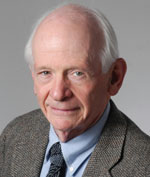Charles Birdsall
- Birthdate
- 1925
- Birthplace
- New York, NY, USA
- Death date
- 2012/03/06
- Associated organizations
- Hughes Aircraft Company, General Electric (GE), University of California
- Fields of study
- Plasma physics
- Awards
- IEEE Marie Sklodowska-Curie Award
Biography
Dr. Charles "Ned" Birdsall was born in 1925 in Manhattan, and attended grade school in New Jersey before moving to North Carolina and subsequently Rocky River, OH where he graduated from high school in 1943. Birdsall attended the University of Michigan, where he graduated with BSEs in electrical engineering and engineering mathematics in 1946. In 1948 he received his MSE from the University of Michigan, during which he held summer jobs at Bell Labs in New York and RCA Laboratories in Princeton, both dealing with microwave tube research. He received his Ph.D. from Stanford in 1951, and was hired by Hughes Aircraft Company to work on microwave tubes, including resistive-wall, reactive-wall and rippled-wall amplifiers, as well as periodic structures (e.g., ring-bar helix) and large-C analysis for high power traveling-wave tubes, leading to the first multikilowatt TWT at X-band.
After Hughes Aircraft Company in 1955, Birdsall worked at the General Electric Microwave Lab in Palo Alto, CA as the leader of the electron physics group, working on electron guns, streams and traveling-wave tubes. Birdsall's work at General Electric and Hughes Aircraft earned him 27 patents, election to IEEE Fellow and led to the publication of 14 journal articles.
In 1959, Dr. Birdsall joined the faculty of the Electrical Engineering Department at the University of California at Berkeley, where he a number of courses. These include Electromagnetic Fields and Waves, using the classic Fields and Waves in Modern Radio textbook authored by Ramo, Whinnery and Van Duzer, Plasmas and Electron Beams, the first programming course at UC Berkley in 1963 using Fortran 4, a part of the graduate course on plasmas adding in occasional simulations, esp. of nonlinear of instability growths, saturation, and drafted the text Plasma Physics Via Computer Simulation with with Bruce Langdon. He also founded and chaired the campus-wide Energy and Resources Group from 1972-1974, which became quite successful, graduating over 300 students to date, and was chair of the College of Engineering Energy and Energy Resources Committee in 1977-1978 and 1979-1980. In 1991 he retired from regular teaching, but still actively focused on research.
In addition to his teaching duties, Dr. Birdsall stayed active in research at UC Berkley. One of his first contributions to the University's research was the discovery of virtual cathode oscillations using computer simulation with W.B. Bridges. His research interests soon moved to high temperature plasmas, with emphasis on understanding instabilities, heating and transport, through development and application of many-particle computer simulations. Birdsall was an active consultant to industry and in 1967 he founded the plasma theory and simulation research group. In 1981-1982 he began to study plasma-surface interactions while on leave from UC Berkley as Foreign Research Associate at IPP in Nagoya, Japan. In 1988, with K. Theilhaber, he made the discovery of the Kelvin-Helmholtz instability at the boundary of a crossed-field plasma. His research in the final years of his life was focused on bounded plasmas especially laboratory discharges, including collisions (Monte Carlo collisions, PIC-MCC codes), possible full fusion reactor, and microwave electron beam device simulations, all with visualizations.
Dr. Birdsall received several awards, including the Sylvania Fellowship 1948-49; National Research Fellow (RCA Fellowship in Electronics), from NRC 1949-51; Visiting MacKay Professor, University of California, Berkeley, 1959; Professor, Miller Institute for Basic Research in Science, 1963-64 (University of California, Berkeley); Associate Editor, IEEE Transactions on Electron Devices, 1964; NSF Grantee, U.S. Japan Cooperative Science Program, 1966; Senior Visiting Fellow, University of Reading, England, Summer 1976; Foreign Research Associate, Institute of Plasma Physics, Nagoya University, Nagoya, Japan, Fall 1981 and Winter 1982; Visiting Chevron Professor of Energy, California Institute of Technology, Pasadena, California, Spring and Summer 1982; Guest of Academia Sinica, China, lectured at Beijing and Hefei, September 1982; Visiting Research Scholar at Max Planck Institute for Plasma Physics, Garching, Germany and at Institute for Theoretical Physics, University of Innsbruck, Austria, Winter 1985; IEEE Plasma Science and Applications Award of the IEEE Nuclear and Plasma Sciences Society ; awarded June 1988 (first time given); Joint Institute of Fusion Studies (JIFT), Visiting Professor, Institute of Plasma Physics, Nagoya University, Japan, Fall 1988; Fulbright Award, University of Innsbruck, Austria, Spring 1991; Berkeley Citation, 1991; JIFT Visiting Professor, NIFS, Nagoya, March-May 2002; Visiting Prof. Gunma University, Japan, Sept. to Dec. 2003. Dr. Birdsall was also selected to be the first award recipient of the IEEE Marie Sklodowska-Curie Award, "for theoretical investigations and fundamental discoveries involving microwave tubes, electron beam physics and particle-in-cell simulation of plasma physics."
Dr. Birdsall was also a member of Tau Beta Pi, Phi Kappa Phi, Sigma Xi, Eta Kappa Nu; IEEE (Fellow, 1962); American Physical Society (Fellow, 1972); American Association for the Advancement of Science (Fellow, 1981).
Outside his career, Dr. Birdsall was known for his love of hiking and skiing in the Sierra Nevada mountains. He completed also many road races and marathons, including two Boston Marathons, and the Napa Marathon when he was in his 70s. He was a loyal member of the Orinda Roadrunners.
